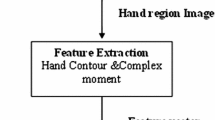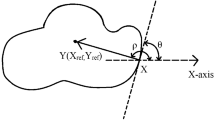Abstract
Complex-valued neural networks (CVNNs), that allow processing complex-valued data directly, have been applied to a number of practical applications, especially in signal and image processing. In this paper, we apply CVNN as a classification algorithm for the skeletal wireframe data that are generated from hand gestures. A CVNN having one hidden layer that maps complex-valued input to real-valued output was used, a training algorithm based on Levenberg Marquardt algorithm (CLMA) was derived, and a task to recognize 26 different gestures that represent English alphabet was given. The initial image processing part consists of three modules: real-time hand tracking, hand-skeletal construction, and hand gesture recognition. We have achieved; (1) efficient and accurate gesture extraction and representation in complex domain, (2) training of the CVNN utilising CLMA, and (3) providing a proof of the superiority of the aforementioned methods by utilising complex-valued learning vector quantization. A comparison with real-valued neural network shows that a CVNN with CLMA provides higher recognition performance, accompanied by significantly faster training. Moreover, a comparison of six different activation functions was performed and their utility is argued.














Similar content being viewed by others
References
Van Trees HL (2002) Optimum array processing. (Detection, estimation, and modulation theory, part IV), 1st edn. Wiley-Interscience, New York, pp 1–1443
Buchholz S, Le Bihan N (2008) Polarized signal classification by complex and quaternionic multi-layer perceptrons. Int J Neural Syst 18(2):75–85
Calhoun VD, Adali T, Pearlson GD, Van Zijl PCM, Pekar JJ (2002) Independent component analysis of fMRI data in the complex domain. Magn Reson Med 1:180–192
Hirose A (1994) Independent component analysis of fMRI data in the complex domain. Neural Process Lett 1:6–8
Stuber GL (2001) Principle of mobile communication. Kluwer, Boston
Helstom CW (1995) Elements of signal detection and estimation. Prentice Hall, New Jersey
Wu RY, Tsai WH (1993) A single-layer neural network for parallel thinning. Int J Neural Syst 3(4):395–404
Raptis M, Kirovski D, Hoppe H (2011) Real-time classification of dance gestures from skeleton animation. In: Proceedings of the 2011 ACM SIGGRAPH/Eurographics symposium on computer animation, pp 147–156
Alonso-Weber JM, Sanchis A (2011) A skeletonizing reconfigurable self-organizing model: validation through text recognition. Neural Process Lett 34(1):39–58
Amin MdF, Murase K (2009) A single-layered complex-valued neural network for real-valued classification problems. Neurocomputing 72:945–955
Amin MdF, Muhammad IA, Ahmed Yarub AN, Murase K (2011) Wirtinger calculus based gradient descent and levenberg-marquardt learning algorithms in complex-valued neural networks. In: 2011 international conference on neural information processing (ICONIP 2011), Shanghai, China, pp 550–559
Hafiz A, Amin MF, Murase K (2011) Real-time hand gesture recognition using complex-valued neural network (CVNN). 2011 international conference on neural information processing (ICONIP 2011), Shanghai, China, 541–549
Shotton J, Sharp T (2011) Real-time human pose recognition in parts from single depth images. Published at Microsoft Research in Cambridge, Statosuedu (2)
Sobel I, Feldman G (1968) A 3 \(\times \) 3 isotropic gradient operator for image processing. Presented at a talk at the Stanford Artificial Project. unpublished but often cited
Huang L, Wan G, Liu C (2003) An improved parallel thinning algorithm. In: Proceedings of seventh international conference on document analysis and recognition, pp 780–783
Hirose A (2006) Complex-valued neural networks. Springer, Beriln, pp 1–160
Kim T, Adal T (2003) Approximation by fully complex multilayer perceptrons. Neural Comput 15:1641–1666
Geotge MG, Koutsougeras C (1992) Complex domain backpropagation. IEEE Trans Circuits Syst II 5:330–334
Hagan M, Menhaj M (1994) Training feedforward networks with the Marquardt algorithm. IEEE Trans Neural Netw 6:989–993
Kohonen T (1995) Learning vector quantization. In: Arbib MA (ed) The handbook of brain theory and neural networks. MIT Press, Cambridge, MA, pp 537–540
Acknowledgments
This study was supported by grants to K.M. from Japanese Society for Promotion of Sciences and Technology, and the University of Fukui.
Author information
Authors and Affiliations
Corresponding author
Rights and permissions
About this article
Cite this article
Hafiz, A.R., Al-Nuaimi, A.Y., Amin, M.F. et al. Classification of Skeletal Wireframe Representation of Hand Gesture Using Complex-Valued Neural Network. Neural Process Lett 42, 649–664 (2015). https://doi.org/10.1007/s11063-014-9379-0
Published:
Issue Date:
DOI: https://doi.org/10.1007/s11063-014-9379-0




